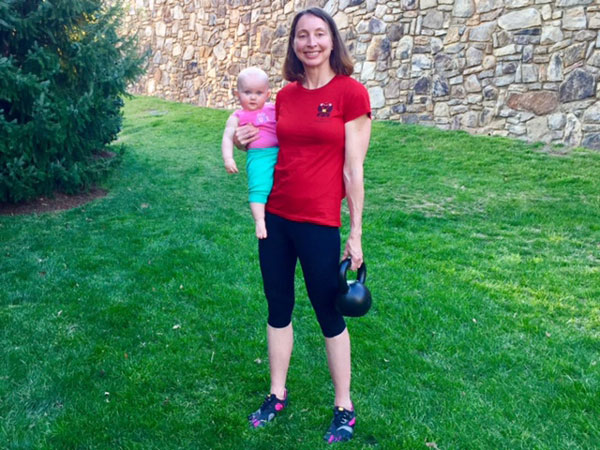
“You need to avoid any high-impact exercises, running, and lifting heavy anything heavier than about 10-15 pounds.” As an avid CrossFitter, Boston Marathon-qualifier and finisher, triathlete and fitness enthusiast, these words from my doctor were difficult to digest. But having just confirmed I was pregnant at nearly 43 years of age, and with multiple high-risk factors, including two miscarriages within the prior two years, he did not want me to take any chances. I decided not to take the advice—or spend my pregnancy—lying down. Instead, I set out to find a way to stay fit and active within these safety parameters.
I had first been introduced to kettlebells a few years earlier at my CrossFit box, but the only formal training I had was a 90-minute seminar taught by an RKC-certified instructor at another fitness certification earlier that year. The seminar showed me the power of the kettlebell and sparked my interest. But after the seminar, I went back to my regularly scheduled programming—CrossFit and running, until my doctor put the kibosh on both of these activities. I asked my doctor what he thought about kettlebells, and he admitted to not knowing much about them. He asked if they were a high-impact activity (no) and whether I could keep the weight low (yes, I could). So, with his blessing, I picked up a kettlebell and started swinging.
Eight months later, I gave birth to a gorgeous, healthy baby girl. My love for her and for kettlebells continues to grow every day. Throughout my pregnancy, I spent my free time reading, researching and following experts on kettlebells and prenatal fitness. I focused on learning the proper form of the six foundational RKC moves, while designing a balanced program that took into account the limitations associated with my pregnancy.
It is likely you have or will have a client who is pregnant, and I want to share the top six lessons I learned through my own trial-and-error. Hopefully this will help you coach them effectively and safely throughout their pregnancy while avoiding the common pitfalls even top trainers make when working with moms-to-be.

1. Encourage your client to partner with her doctor about fitness and nutrition. Doctors are medical professionals; most are not fitness or nutrition professionals. As a Precision Nutrition Level 2-certified nutrition coach and lifelong athlete, early on it became clear that I was more knowledgeable about fitness and nutrition than my doctor. He also admitted it! While respecting my doctor’s advice and prioritizing my own health and safety and the health and safety of my baby, I challenged some of his fitness recommendations, providing research and data to support my position.
Because of our back-and-forth, I was able to create a pregnancy fitness program that satisfied my own needs and interests but addressed my doctor’s concerns. It is critical that your client has clearance to train from a medical professional prior to beginning a prenatal program. Partnering with the doctor can help you and your client navigate pregnancy in a way that keeps her healthy, happy and fit.
2. Keep the workouts short and simple. Pregnancy is not the time for lengthy and complicated workouts. Throughout a pregnancy, women often experience bouts of fatigue (particularly in the first and third trimesters) and nausea (most prevalent in the first trimester aka “morning sickness,” though mine hit in the late afternoon and evening). Expectant moms are also usually juggling numerous career and household responsibilities while preparing for the baby. I programmed workouts that lasted as little as 15 minutes, and supplemented these sessions with daily walks with my puppy. This allowed me to easily fit 4-5 workouts a week into my busy schedule.
3. Stay flexible with your clients’ programming and give them options for when they are not feeling 100% or are stressed. My workouts during pregnancy followed my “3S System” of programming: include skill, strength, and sweat in each session. Instead of a specific number of sets to complete in a workout, each workout section was time-based (As Many Rounds As Possible or AMRAP-style). This allowed me to adjust the length of my workouts according to my schedule on any given day.
A typical workout looked something like this:
Warm-up:
Squat-to-stand: 5
Bodyweight single-leg deadlift: 5 R/L
Light halo: 5 R/L
Skill Work:
(5-10 minute AMRAP)
Bodyweight single-leg squat-to-box (pistol practice): 2-3 R/L
Strength Work:
(5-15-minute AMRAP)
One-arm rows: 6-8 R/L
Double kettlebell suitcase deadlift: 6-8
Seated one-arm military press: 6-8 R/L
Sweat Work:
(5-10 minute EMOTM Every Minute On The Minute) complete:
Two-hand kettlebell swings: 5
Double kettlebell farmer’s carry: 20 seconds
Cool Down:
Hamstring stretch
Hip flexor stretch
Diaphragmatic breathing
Stay tuned for part 2, where I will cover the next 3 tips for trainers working with expecting mamas.
Be happy, healthy and strong,
Kathleen Walters, RKC
****
Written in collaboration with Master RKC Michael Krivka
Kathleen Walters, RKC is known as the “Kettlebell Mama”. She is a lifelong athlete based in Washington, DC, who specializes in coaching busy moms and moms-to-be in-person and remotely, helping them incorporate healthy fitness and nutrition habits into their chaotic “mom life.” To learn more about Kathleen and her coaching services, email her at kathleen@bellsandpeppers.com, or visit her website and popular blog at http://www.bellsandpeppers.com.